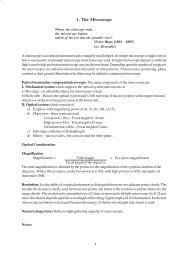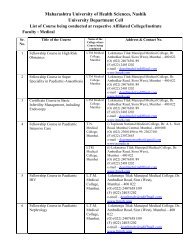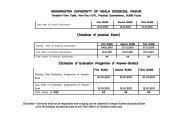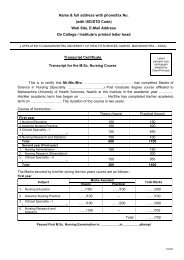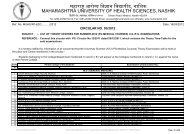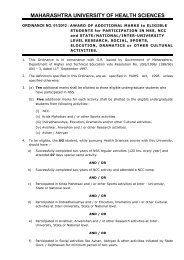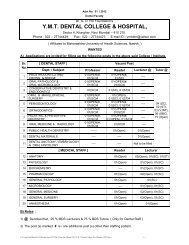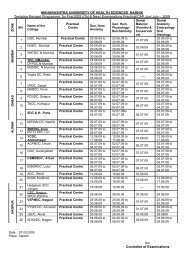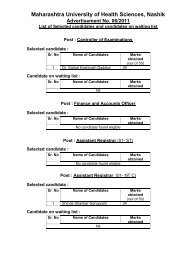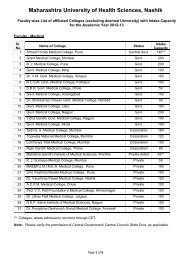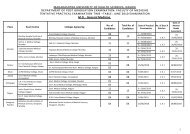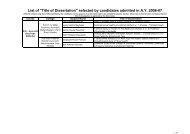MD - Maharashtra University of Health Sciences
MD - Maharashtra University of Health Sciences
MD - Maharashtra University of Health Sciences
Create successful ePaper yourself
Turn your PDF publications into a flip-book with our unique Google optimized e-Paper software.
Passed by Academic Council (Resolution No. 355/2006) dtd. 30/05/2006,<br />
subject to Uniformity in the Examination pattern.<br />
MAHARASHTRA UNIVERSITY OF HEALTH<br />
SCIENCES, NASHIK<br />
SYLLABUS OF M.S. ORTHOPAEDICS
MAHARASHTRA UNIVERSITY OF HEALTH<br />
SCIENCES<br />
NASHIK - 422 005.<br />
Syllabus :<br />
Syllabus for M.S. (Orth.)<br />
1) Basic <strong>Sciences</strong> Related to Locomotor system.<br />
1) Development, histology <strong>of</strong> bone, cartilage, collagen, muscles and nerve.<br />
2) Physiology <strong>of</strong> bone, carliage, muscle & nerve.<br />
2) Surgical pathology related to bones, cartilage, muscle, collagen & nerve in<br />
various congenital affections, infections, Tumours and timorous conditions<br />
and metabolic affections.<br />
3) Orthopaedic diseases<br />
• Metabolic bone disease<br />
• Bone infections – Acute and Chronic<br />
• Congenital deformities and development conditions <strong>of</strong> upper<br />
extremity, lower extremity, spine general defects.<br />
• Diseases <strong>of</strong> joints<br />
• Tumours <strong>of</strong> Bones<br />
• Orthopaedic Neurology including spine bifida, Poliomyelitis and<br />
cerebral palsy.<br />
• Diseases <strong>of</strong> muscle, fibrous tissue and vessels<br />
• Regional orthopaedic conditions related to neck, shoulder, elbow,<br />
wrist, hand, hip, knee, ankle , foot, back and pelvis.<br />
• Special subject – Orthopaedic Radiology Amputation and<br />
disarticulation physiotherapy and rehabilitation<br />
Recent advances in orthopaedic diseases.<br />
4) General principles <strong>of</strong> Surgery and Traumatology.<br />
• Wound healing<br />
• Fracture healing<br />
• Rehabilitation after bone and joint injuries<br />
• Systematic response to injury<br />
• Acute trauma care and early management <strong>of</strong> injured<br />
• Injury to head, face, chest, abdomen, vessels & nerves.<br />
• Polytrauma<br />
• Fracture & dislocations in all bones and joints including diagnosis,<br />
classifications, various modalities <strong>of</strong> investigation and operative nonoperative<br />
treatment including complications.<br />
• Fractures in children<br />
• Pathological fractures<br />
• Recent Advance in various fractures and complications management.
5) Exposure to surgical techniques & surgical approaches to various regions to<br />
manage common infection, tumor, joint diseases, different type <strong>of</strong> trauma,<br />
congenital, neurological and miscellaneous conditions.<br />
6) Principles <strong>of</strong> Arthroscopy microsurgery & Arthroplasty.<br />
7) Orthotics & Prosthetics, disability calculation, Bio-mechanics <strong>of</strong> gait, splints.<br />
8) Thesis – Aim is to train the PG student in research work. Topics should be in<br />
experimental, clinical, retrospective analysis or combination such that students<br />
is encouraged to do exhaustive reference work. Topics should be relevant to<br />
subject and region <strong>of</strong> work. Topics should allotted within first three months <strong>of</strong><br />
training. The candidate should complete review <strong>of</strong> literature by end <strong>of</strong> the first<br />
year and submit his completed thesis six months before the final examination.<br />
Subject <strong>of</strong> thesis should be approved by <strong>University</strong> within first six months.<br />
9) Under Graduate teaching in clinical methods.<br />
10) Seminar presentation on common topics.<br />
11) Journal reading and discussion.<br />
12) Case presentation, ward record maintenance.<br />
13) Adequate experience in closed reducation <strong>of</strong> various fractures, as isting major<br />
operation, independent operative management <strong>of</strong> common orthopaedic<br />
condition.<br />
14) Preparation <strong>of</strong> paper for presentation in conference.<br />
15) Preparation <strong>of</strong> article for publication.
MAHARASHTRA UNIVERSITY OF HEALTH<br />
SCIENCES<br />
NASHIK - 422 005.<br />
Scheme <strong>of</strong> Theory Exam. in Orthopaedics for M.S. (Ortho.) Exam.<br />
(As per Direction No. 01/2008 dtd. 26/05/2008<br />
Provisional Syllabus for Diploma in Orthopaedics<br />
1) Basic <strong>Sciences</strong> related to Locornotor System<br />
i) Histology <strong>of</strong> bone, cartilage, muscles, collagen, Nerves<br />
ii) Physiology <strong>of</strong> bone, cartilage, muscles, collagen and Nerves<br />
2) Surgical Pathology related to Bones, cartilage, Muscle, collagen and Nerves in<br />
various.<br />
Congenital affection, infections, Tuirnours and turnours conditions a<br />
metabolic affection.<br />
3) General principles <strong>of</strong> surgery and Traurratology<br />
i) Wound healing<br />
ii) Fracture healing<br />
iii) Rehabilitation after bone and joint injury<br />
iv) Systemic response to injury<br />
v) Fracture and dislocation in all bones its management including<br />
complications.<br />
vi) Injury to chest, abdomen and head<br />
vii) Ploytrauma<br />
viii) Fractures in children<br />
4) Orthopaedics diseases<br />
i) Metabolic Bone Disease<br />
ii) Bone infections – Acute and chronic<br />
iii) Congenital and development Deformities - upper extremity<br />
- Lower extremity<br />
- Spine<br />
- General defects<br />
iv) Disease <strong>of</strong> joints<br />
v) Tumours <strong>of</strong> Bones<br />
vi) Orthopaedics Neurology – Spina bifida, Polio, Cerebral Palsy<br />
vii) Disease <strong>of</strong> muscles, nerves , vessels and fibrous tissues<br />
viii) Regional Orthopaedics related to spine, shoulder<br />
ix) Elbow, wrist, hip, knee, ankle and foot.<br />
x) Special Subjects - Orthopaedics Radiology<br />
- Amputation<br />
- Physiotherapy<br />
- ALTS<br />
- First Aid
Examination Scheme for D. (Ortho)<br />
(As per Direction No. 01/2008 dtd. 26/05/2008<br />
Theory Exam. Total three papers, each <strong>of</strong> three hours duration and carrying 80 marks<br />
each. Total = 240 Marks.<br />
Paper I - Anatomy, Physiology and Pathology as applicable to<br />
Orthopaedics.<br />
Paper II - Traumatology and general Surgery,<br />
Paper III - General Orthopaedics<br />
Each paper will have four questions <strong>of</strong> 25 marks each.<br />
Practical Exam.<br />
Total Marks = 300<br />
Long Case 1 = 100<br />
Short Case 2 50 X 2 = 100<br />
Tables : 100<br />
1) Instruments = 20<br />
2) X-rays = 20<br />
3) Specimen = 20<br />
& Bones and splints<br />
4) Ward round = 20<br />
5) Operation = 20<br />
Internal Exam.<br />
Total Marks = 100<br />
Theory = 50<br />
Practical = 50<br />
For further examination the internal assessment marks should be calculated<br />
based on periodical tests in theory and practical at every term i.e. 4 tests for D.<br />
(Ortho)<br />
Passing will be 50% <strong>of</strong> the marks in each head separately i.e. Theory, Practical<br />
and internal examination. Total marks should be 50% <strong>of</strong> the total marks for passing



